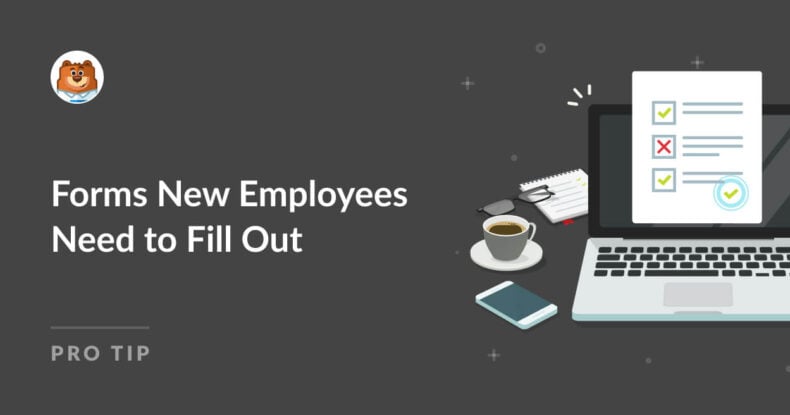Resumen de la IA
Así que has hecho una nueva contratación - ¡enhorabuena! Has encontrado a la persona ideal. Pero ahora viene la parte menos romántica: el papeleo.
Eso no significa que tenga que ser una molestia. Con los formularios adecuados, puede mejorar la incorporación de sus empleados, guiar el cumplimiento y causar una excelente primera impresión.
En esta entrada de blog, te guiaré a través de los formularios más importantes que tu nuevo empleado necesita llenar, y cómo puedes crearlos rápida y fácilmente usando WPForms.
Los 10 formularios que deben rellenar sus nuevos empleados
- 1. Carta de oferta
- 2. Incorporación de empleados
- 3. Contacto en caso de emergencia
- 4. Reconocimiento del manual
- 5. Reconocimientos del Código de Conducta o de la Política
- 6. Reconocimiento de equipos y activos
- 7. Acuerdo de confidencialidad
- 8. Acuerdos de no competencia o no captación
- 9. Formularios de formación
- 10. Encuestas de opinión
- PREGUNTAS FRECUENTES
1. Carta de oferta
Este formulario es su oferta oficial de empleo, lo describe todo, desde el cargo hasta el salario, y marca la pauta para un proceso de incorporación profesional y fluido.
También le protege tanto a usted como al empleado, ya que los detalles importantes se consignan por escrito y se documentan de forma segura.
Qué incluir en el formulario de la carta de oferta:
- Nombre y cargo del empleado
- Fecha de inicio y lugar de trabajo
- Salario o pago por hora
- Horario de trabajo (por ejemplo, a tiempo completo, a tiempo parcial)
- Situación laboral (por ejemplo, exento/no exento)
- Campo de firma para la aceptación
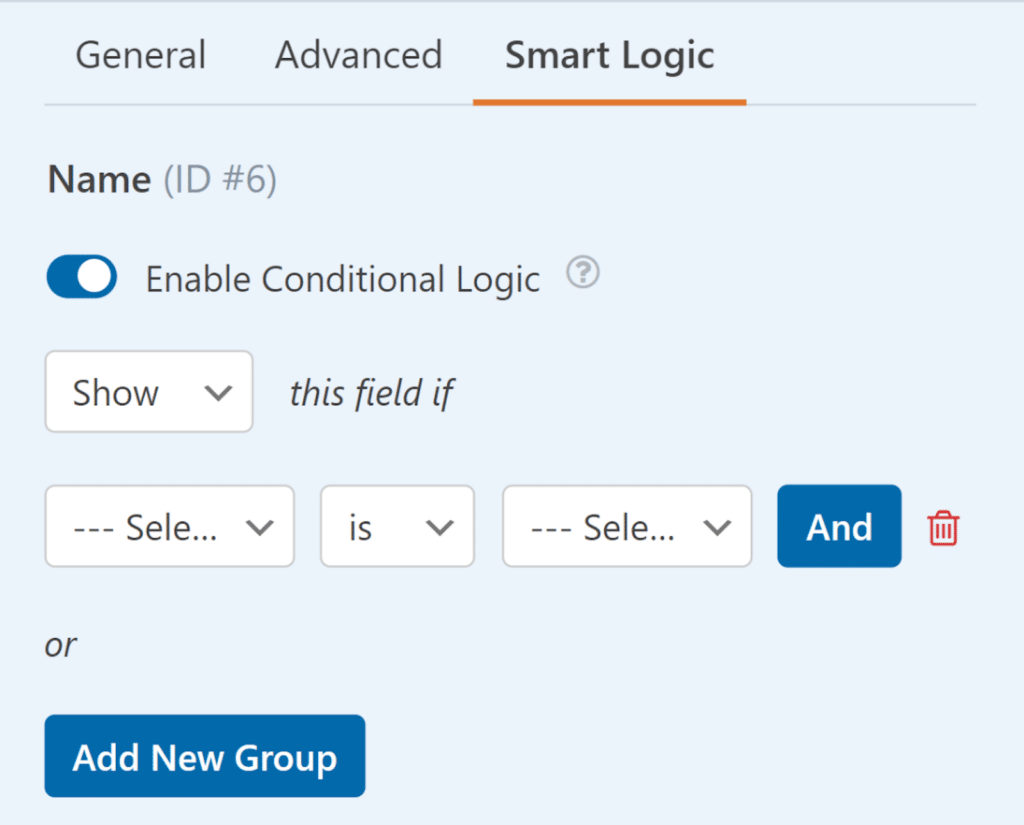
Consejo WPForms: Agregue lógica condicional si desea mostrar términos específicos basados en rol o departamento.
Añade NPS a tu formulario de Wordpress ahora mismo
2. Incorporación de empleados
Este formulario "todo en uno" recopila información esencial personal y relacionada con el trabajo para que pueda preparar rápidamente a su nuevo empleado. Mantiene a RRHH organizado y se asegura de que nada se pierda.
Qué tener en cuenta en los formularios de incorporación de empleados:
- Nombre legal completo e información de contacto
- Información de contacto en caso de emergencia
- Nombre y pronombres preferidos
- Información sobre el departamento, la función y el responsable
- Reconocimiento de las políticas
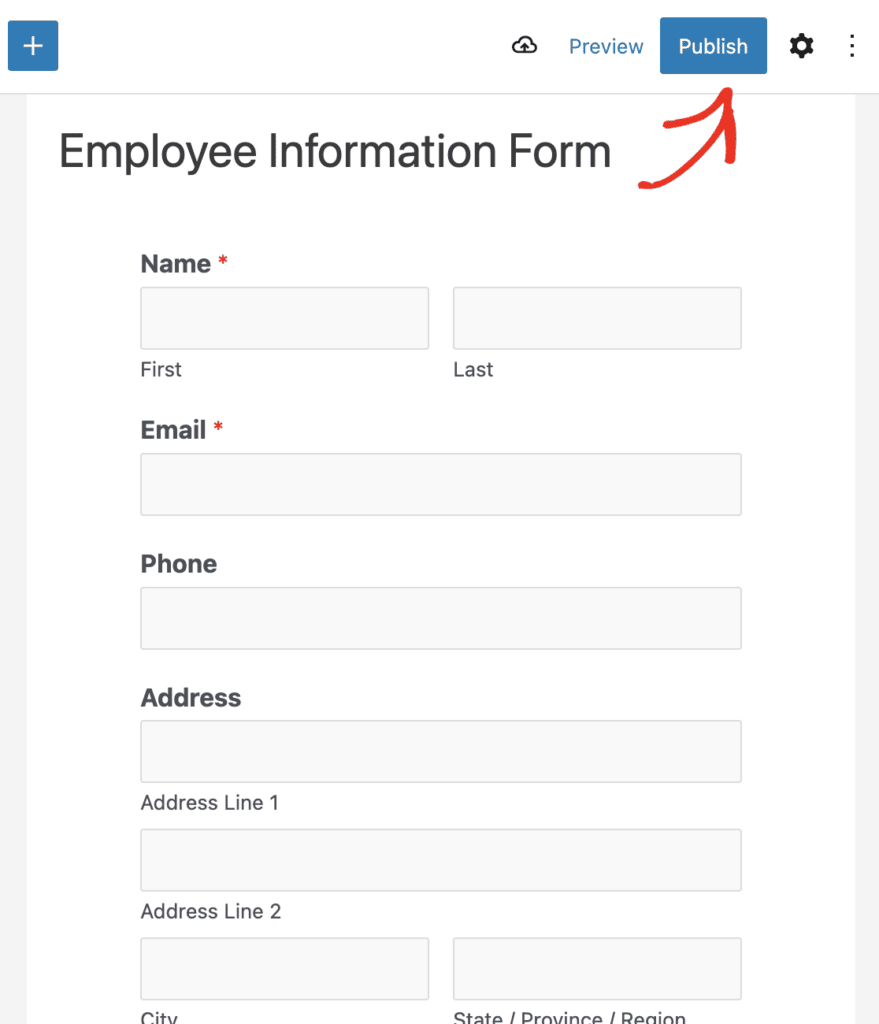
Consejo WPForms: Utilice un formulario de varias páginas para mantener las cosas limpias y fáciles de usar. Y activa Guardar y reanudar más tarde si tu formulario tiene muchos campos.
El siguiente puñado de formularios que se enumeran aquí pueden muy bien formar parte de su proceso de "incorporación" de empleados, o la información puede estar incluida en algún lugar de su formulario de incorporación. Pero para más detalles e ideas, vamos a desglosarlo un poco más.
3. Contacto en caso de emergencia
La seguridad ante todo.
El formulario de contacto de emergencia recoge los nombres y números de las personas a las que debe llamar si ocurre algo inesperado. Es una parte rápida pero importante de la incorporación de los empleados que demuestra que te preocupas por ellos.
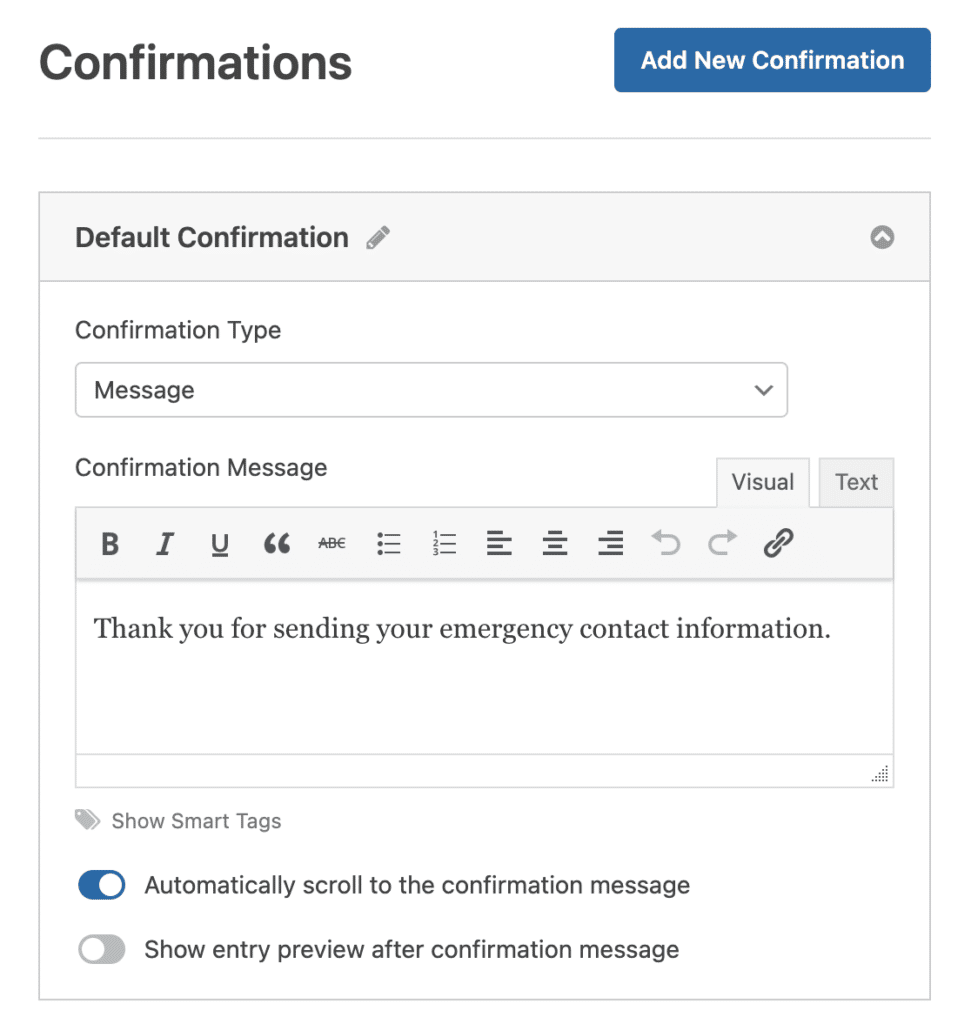
Qué pedir en el formulario de contacto de emergencia:
- Nombre y relación de la persona de contacto
- Números de teléfono (casa, móvil, trabajo)
- Correo electrónico (opcional)
- Contacto alternativo (si procede)
Consejo WPForms: Utilice el campo Repetidor si desea recopilar múltiples contactos de emergencia limpiamente.
4. Reconocimiento del manual
¡Rulez es rulez!
Utilice este formulario para confirmar que su empleado ha recibido y leído el manual de su empresa. Es la prueba documental de que "te hemos explicado las normas", y es importante para tu tranquilidad.
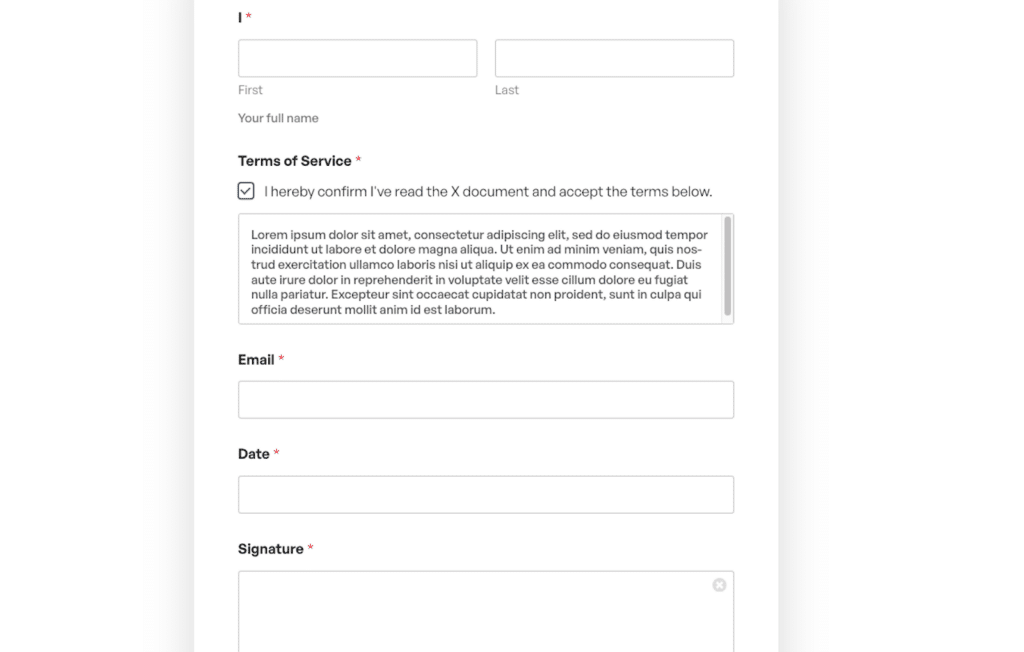
Qué poner en el formulario de reconocimiento del Manual:
- Casilla de confirmación
- Fecha de recepción
- Campo de firma
Consejo WPForms: Incluya un cuadro de comentarios opcional (campo de párrafo) si los empleados tienen preguntas.
5. Reconocimientos del Código de Conducta o de la Política
A veces, ciertas políticas de empresa necesitan su propio momento de reconocimiento.
Estos tipos de formularios permiten destacar normas específicas -como el uso de Internet, las políticas de seguridad o las directrices sobre redes sociales- y obtener un reconocimiento por escrito. Son especialmente útiles para las políticas que cambian con más frecuencia que el manual completo.
Qué incluir en el formulario del Código de conducta:
- Breve descripción de la política
- Enlace a la política completa
- Casilla de verificación del acuerdo
- Campo de firma
Lea también: Cómo proteger formularios con contraseña o restringir el acceso en función de los roles de usuario.
6. Reconocimiento de equipos y activos
Si vas a entregar ordenadores portátiles, uniformes o licencias de software, este formulario mantiene un registro claro de lo que se ha entregado. Los empleados firman para indicar que han recibido su equipo y se comprometen a cuidarlo.

También es muy útil para el offboarding.
Qué recoger en su formulario de reconocimiento de equipo:
- Descripción de los artículos entregados (por ejemplo, ordenador portátil, teléfono, tarjeta de acceso)
- Números de serie
- Estado en el momento de la emisión
- Firma para confirmar la recepción y el acuerdo
Consejo WPForms: Utilice listas desplegables o de casillas de verificación para estandarizar las opciones de equipamiento.
7. Acuerdo de confidencialidad
Un acuerdo de confidencialidad ayuda a proteger la información privada de tu empresa asegurándote de que el nuevo empleado se compromete a no compartir datos confidenciales. Es habitual en muchos puestos y sectores, sobre todo si tu equipo trabaja con secretos comerciales o información de clientes.
Por eso, un formulario digital facilita la recogida de este acuerdo y su almacenamiento seguro.
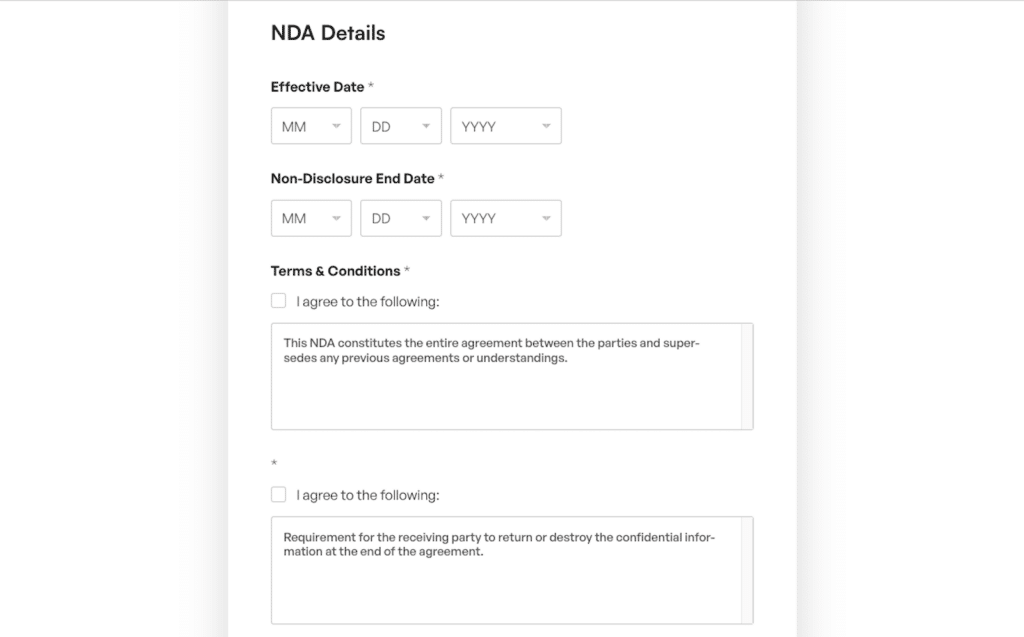
Qué incluir en el formulario de acuerdo de confidencialidad:
- Resumen de lo que se considera confidencial
- Duración del acuerdo
- Consecuencias del incumplimiento
- Firma y fecha del empleado
¿Necesita un ejemplo? Consulte la plantilla de formulario de acuerdo de confidencialidad
8. Acuerdos de no competencia o no captación
Estos acuerdos establecen restricciones para trabajar para la competencia o captar clientes después de dejar la empresa (cuando sea legal). Aunque no todas las empresas necesitan uno, son importantes para proteger las relaciones y la propiedad intelectual.
Qué debe tener en cuenta en su formulario de no competencia:
- Duración y alcance de las restricciones
- Zona geográfica (si procede)
- Firma y acuse de recibo
Nota: Este puede ser un tipo de formulario poco común comparado con la mayoría de estos que usarás para tu negocio. Pero en el caso de que lo necesites, ¡solo quiero que sepas cómo incluirlo en tu sitio!
9. Formularios de formación
Una vez que su empleado finaliza cualquier formación obligatoria, un formulario de finalización de la formación le ayuda a documentarla. Tanto si se trata de seguridad, cumplimiento o herramientas internas, querrá tener pruebas de que se ha completado.
Qué poner en los formularios de finalización de formación:
- Título y fecha de la formación
- Nombre o método del formador (en persona, vídeo, etc.)
- Resultados del cuestionario o comentarios (opcional)
- Casilla de confirmación o firma
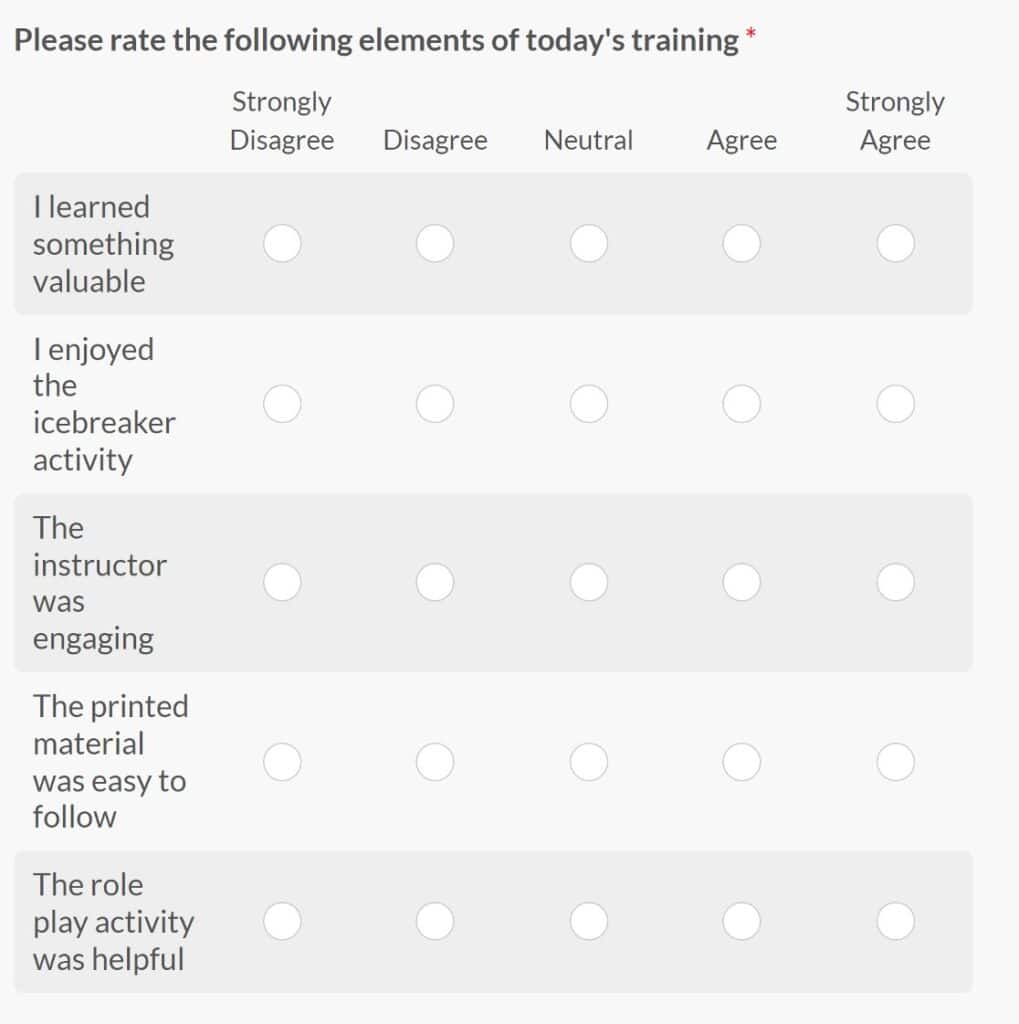
Consejo WPForms: Añada un cuadro de comentarios o una escala de valoración para obtener una respuesta rápida.
10. Encuestas de opinión
Los comentarios de los nuevos empleados le ayudarán a mejorar su proceso de incorporación. Un formulario de comentarios te permite recabar opiniones mientras la experiencia aún está fresca, para que sepas lo que funciona y lo que hay que ajustar.
Pero considere la posibilidad de hacerlo breve y sencillo con casillas de verificación y campos de valoración.

Qué más poner en sus encuestas de opinión:
- Valoración global de la incorporación
- Partes más útiles/menos útiles
- Sugerencias abiertas
- Campo Net Promoter Score (NPS)
Consejo WPForms: Utilice una escala Likert o un campo de valoración por estrellas para que las encuestas sean rápidas y atractivas.
No tiene que hacer malabarismos con archivos PDF ni buscar firmas a mano. Con WPForms, puede crear un flujo de incorporación totalmente digital en cuestión de minutos. Y causar una gran impresión a sus nuevos empleados desde el primer día.
Añade NPS a tu formulario de Wordpress ahora mismo
PREGUNTAS FRECUENTES
¿Puedo recoger firmas digitales en los formularios de mis empleados?
¡Si! WPForms incluye un campo de Firma para que los empleados puedan firmar directamente en el formulario.
¿Y si mi formulario es largo o complicado?
Utiliza la función multipágina para dividirlo en secciones más pequeñas, y activa Guardar y reanudar para que los empleados puedan terminarlo más tarde.
¿Puedo utilizar WPForms sólo para formularios internos de RRHH?
Por supuesto. Puede proteger los formularios con contraseña o restringir el acceso en función de las funciones de los usuarios.
A continuación, aproveche su proceso de solicitud de empleo
Ya que estás en ello -creando formularios que tu nuevo empleado debe rellenar-, podrías respaldarlo aún más. ¿Por qué no tomar el control de todo el proceso, empezando por la solicitud de empleo? No hay necesidad de externalizarlo a una plataforma complicada.
Eche un vistazo a nuestro tutorial completo, Cómo crear un formulario de solicitud de empleo en WordPress, para aprender a ofrecer solicitudes de empleo directamente desde su sitio.
¿Listo para crear tu formulario? Empieza hoy mismo con el plugin más sencillo para crear formularios en WordPress. WPForms Pro incluye un montón de plantillas gratuitas y ofrece una garantía de devolución de dinero de 14 días.
Si este artículo te ha ayudado, síguenos en Facebook y Twitter para más tutoriales y guías gratuitas sobre WordPress.

